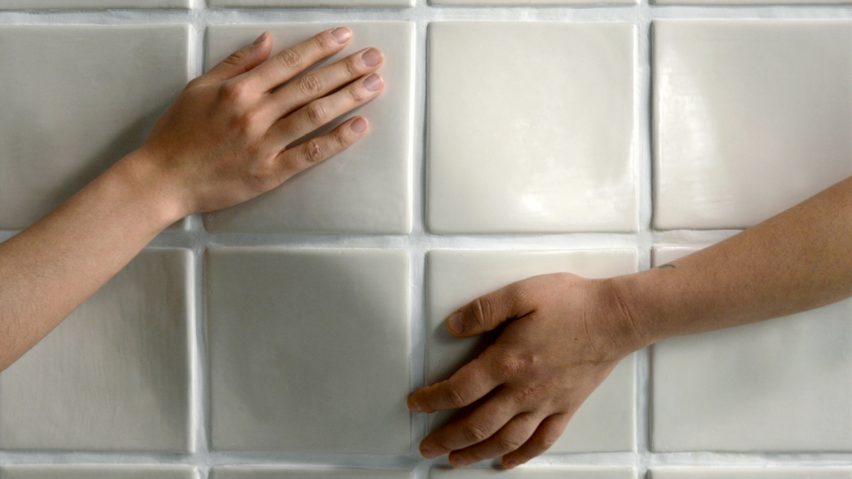Industrial designer Lauren Lee has designed a heated wall for public toilets, which provides women with a communal place to alleviate their menstrual cramps.
The project, called Warm Wall, was design in response to the lack of public amenities designed to serve women during their periods.
Covered in heated slip-cast porcelain tiles, Lee's Warm Wall utilises technology similar to that used in underfloor heating systems. Her working prototype employs electrical heated wires that are positioned behind the tiles.
Women can lean on the curved protrusion of the wall with their abdomens and lower backs, for natural cramp relief by way of pressure and heat.
San Francisco-based Lee, who is a recent graduate of the Master of Industrial Design programme at the Pratt Institute, hopes her Warm Wall will help break the taboo surrounding menstruation, which suggests it is something that should be concealed.
"While periods are one of the few mundane experiences all women share within their lifetimes, architecture and public spaces have little to no consideration for women's recurring needs," said Lee.
"By creating a tangible public resource, this proposal seeks to address the taboo that has largely shaped women's perception of the monthly cycle as something that should be kept hidden from the public realm," she added.
It was this culture of secrecy surrounding periods that drove Lee to design a public amenity rather than a consumer good for purchase. The wall, which she designed for her master thesis project, is designed to address the "common emotional and physical discomfort" of periods rather than hygiene.
"For the last century in the United States, menstruation has gone hand-in-glove with menstrual hygiene and effectively masking one's period," said the designer.
"Induction into womanhood includes adaptation – becoming a deft and stealthy user of feminine hygiene technology, in which success is measured in invisibility. Outside the home, women seldom find accommodations for their time of the month in public places," she added.
"As a transitional space between public and private, the women's restroom hosts a multitude of activities extending far beyond its original purpose," she continued.
"Women take refuge to retouch makeup, change clothes, hold private conversations, or take a quiet moment for themselves. They exchange menstrual supplies, lamentations, and advice. This is how I began thinking about a heated wall – a comforting public bench for menstruation in the bathroom that could support an already existing social dynamic."
Recognising that menstruation is a shared and common experience, the Warm Wall is designed not only to supply women with a warm place to alleviate their cramps, but to also "commiserate" with a friend, stranger.
According to the designer, the wall acts as a "physical and emotional public bench," aiming to build a visible and supportive material culture for periods.
"I wanted to make something clearly visible that could eventually become part of the built environment," the designer told Dezeen. "It could be used alone, shared among groups of women, or spark empathetic conversation between strangers. You could decide to use it or pass by without much thought."
"It could be taken for granted in the same way that toilet paper is. After all, menstruation is no more special of an event than going to the bathroom, so why is nothing publicly provided?" she added.
Lee's design development process involved asking a group of women to test a series of different curves made from cardboard and 3D printed materials, and used their feedback to create her final design.
She found that accommodating a diverse range of bodies and leaning positions would require a very simple form.
"I looked at the manner in which women often subconsciously lean on the wall in casual conversation," Lee told Dezeen. "Like a public bench – it would have to be minimal and subtle in order to be useful to all."
Lee hopes that her Warm Wall project will extend beyond catering to women's needs, and will inspire people to consider how our public environments can show more empathy towards everyone.
Lee is not the only designer trying to break the taboo around periods. Design graduate Ailsa Inglis recently created a menstrual cup aimed specifically at young girls, with the aim of normalising alternative period products.
Meanwhile, the packaging of Thinx organic tampons brings a significant part of menstruation out of hiding – the vagina.

